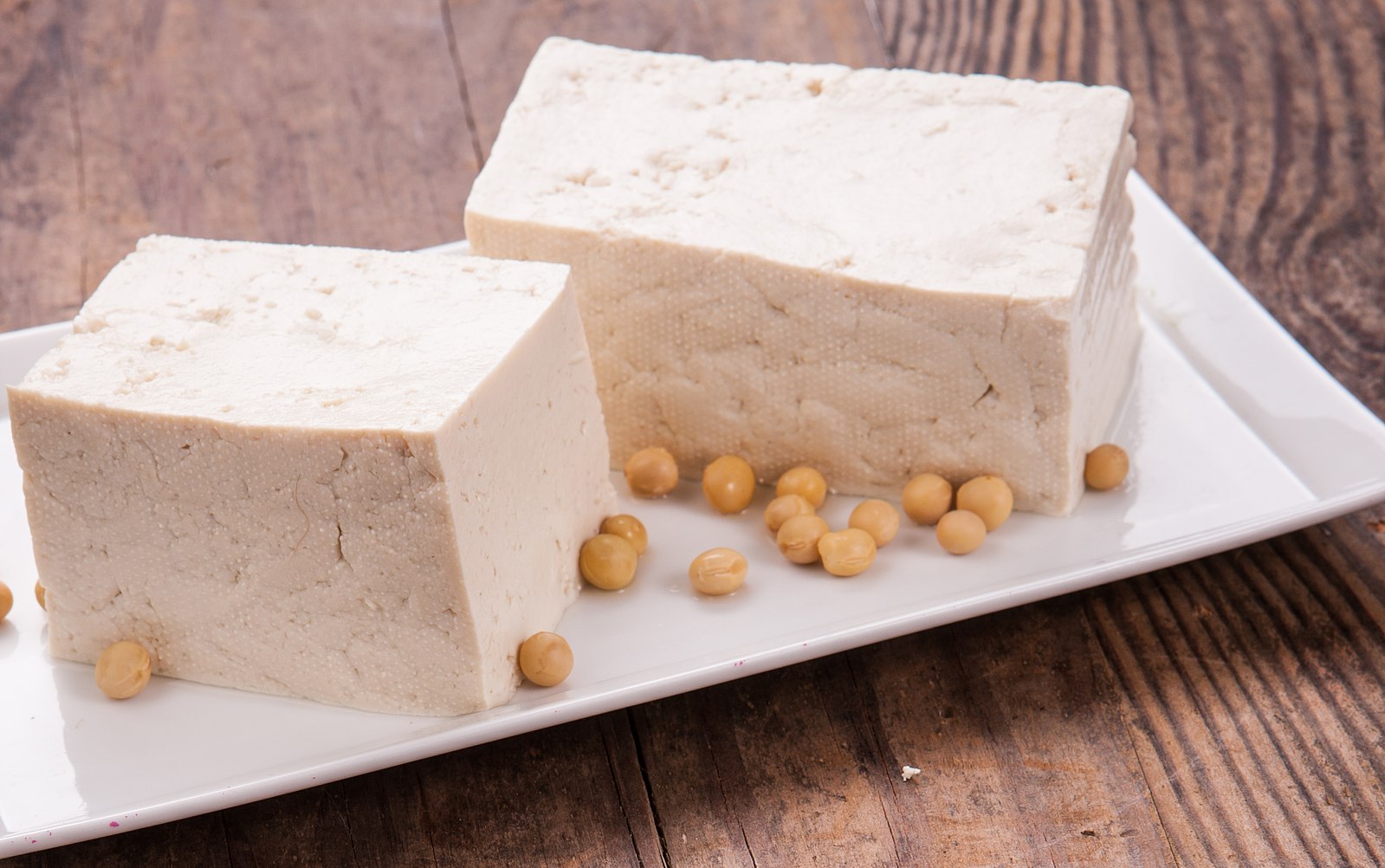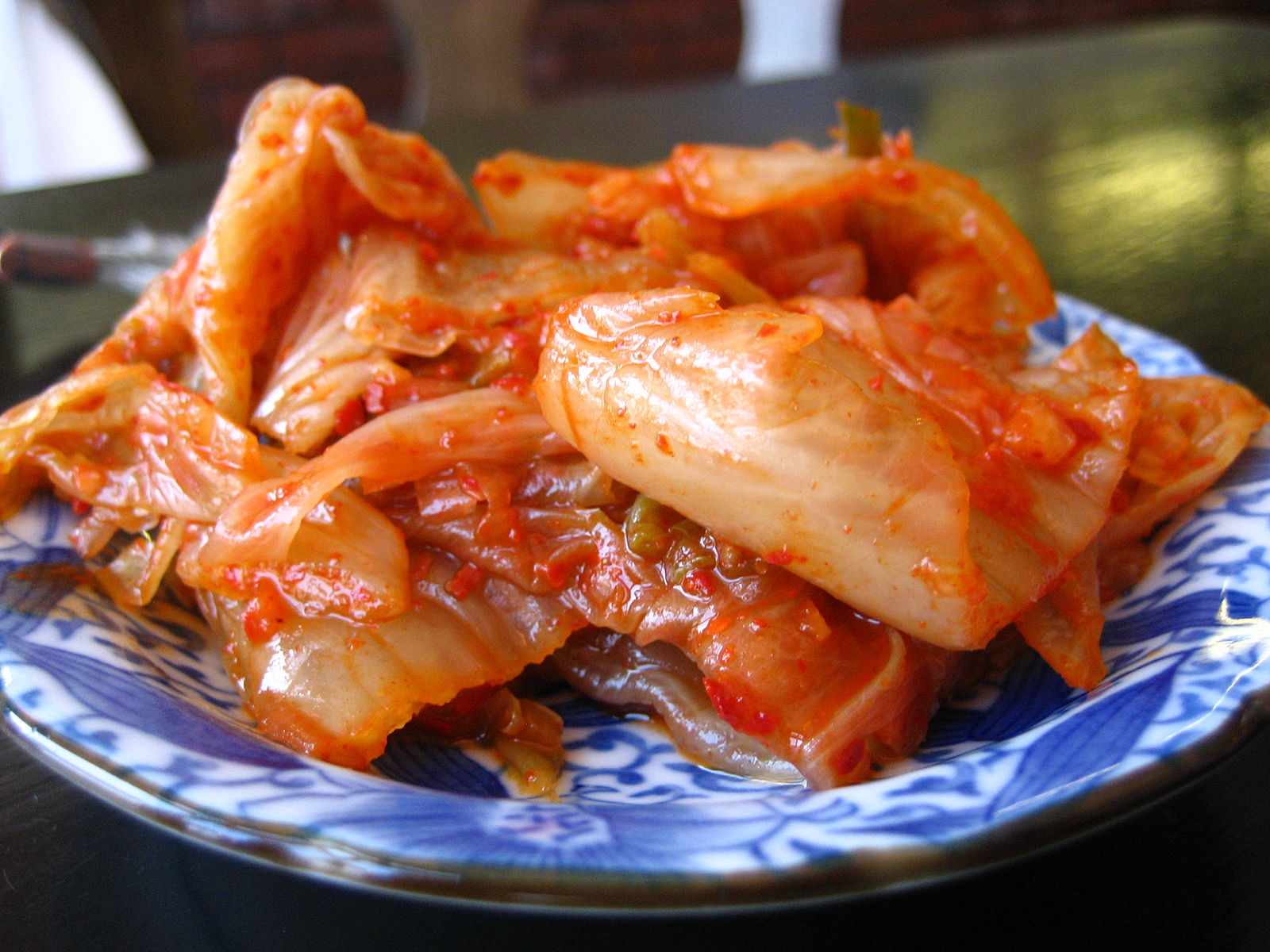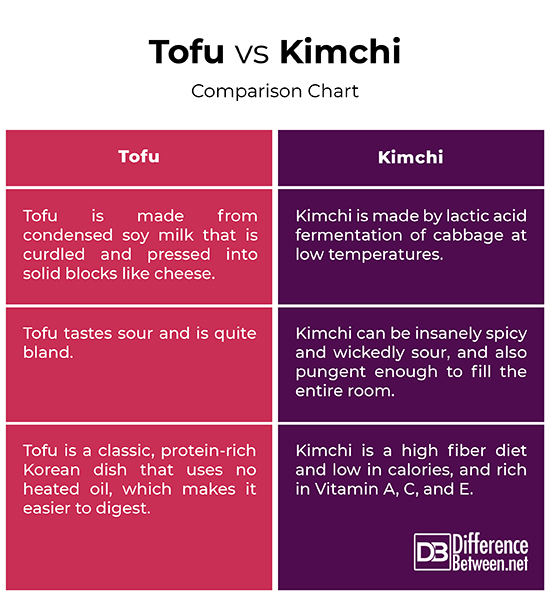Difference Between Tofu and Kimchi
Tofu and Kimchi are a classic delectable pairing with a lot of different variations. They can be enjoyed as a main dish or snack ay any time of the day. Let’s take a look at the two.

What is Tofu?
Tofu is a popular Asian food product made from condensed soy milk that is curdled and pressed into solid blocks which resemble much like cheese. Tofu is an Asian staple food that denotes time-honored traditions, culinary craftsmanship and good health. It is not just a food; tofu is a luxury in many aspects of Asian life and culture. You go to any country in Asia or Southeast Asia, you’ll find tofu practically everywhere, whether it’s a street food joint, a cafeteria or restaurants. Tofu is made from soya beans and soaked in water, crushed and boiled. There are several variations of tofu that go well with different types of dishes. Tofu is available almost everywhere, from wet food markets and neighborhood tofu shops to fancy food halls and supermarkets. Small packaged tofu snacks are often found as impulse buys at Chinese hypermarkets.

What is Kimchi?
Kimchi is a traditional side dish which has become insanely popular in the last two decades here in the west for its unique sour flavor. Kimchi is a staple Korean dish made by lacto-fermentation, the same process used in the making of traditional dill pickles and sauerkraut. The term actually refers to fermented vegetables and made with a variety of different seasonings like sugar, salt, onions, garlic, spring onions, etc. There are a variety of kimchi recipes which are an appetizing way to add more vegetables with vitamins and enzymes to your health-conscious diet. This super delicious Korean food is surprisingly tangy and spicy. While making kimchi at home is fun and doable, most Koreans would still prefer buying ready-to-eat kimchi at markets and grocery stores. Different vegetables are used as main ingredients to make a variety of kimchi dishes.
Difference between Tofu and Kimchi
Preparation
– Both tofu and kimchi are staple culinary delights in Korean cuisine that can be consumed with a variety of dishes. Tofu is made from condensed soy milk that is curdled and pressed into solid blocks which resemble much like cheese. Tofu is also called bean curd. Kimchi is a staple Korean dish made by lacto-fermentation, the same process used in the making of traditional dill pickles and sauerkraut. Different vegetables are used as main ingredients to make a variety of kimchi dishes.
Nutritional Value
– Both tofu and kimchi are rich in iron and they both contain similar amounts of Vitamin A, Vitamin C and Vitamin E. While both are low in saturated fat, Kimchi is mainly made of a lot of vegetables so it naturally is a high fiber diet and also low in calories. Kimchi is an appetizing way to add more vegetables with vitamins and enzymes to your health-conscious diet. Tofu is a classic, protein-rich Korean dish and it uses no heated oil, making it much lighter and easier to digest.
Flavor
– Tofu tastes sour and is quite bland, which makes it so great. It basically has no flavor of its own; it absorbs any flavor of your choosing. Whether fresh and tender or aged, tofu denotes culinary craftsmanship, timeless traditions and good health. Kimchi, on the other hand, can be insanely spicy and wickedly sour, and also pungent enough to fill the entire room with its unique smell. It tastes like a crunchy spicy pickle with a little salt over the top but less acidic in nature.
Tofu vs. Kimchi: Comparison Chart

Summary
Tofu is a classic, protein-rich Korean delight that uses no heated oil, which makes it super lightweight and easier to digest. Tofu is a popular Asian staple food, loved by rich and poor alike and it pervades many aspects of Asian life and culture. Kimchi is Korean specialty dish which can be consumed both as a main dish and side dish. Kimchi is basically fermented vegetables and accompanied by a variety of different seasonings like sugar, salt, onions, garlic, spring onions, etc. Together, they make a classic pairing.
What do you eat kimchi with?
Kimchi is available in a lot of different types, each with their own unique taste. However, the classic kimchi ingredients used are salt, sugar, spring onions, garlic, and a kind of Korean dried chili powder called gochugaru. You can pair kimchi with almost anything – add it to rice, make a stew, eat with omelet, French fries, salad, and more.
Do you eat kimchi hot or cold?
For its probiotic benefits, kimchi can be consumed either cold or barely warmed. It can be eaten as a side dish with every meal, but many people eat it as a main dish. Mostly, it is consumed straight out of the fridge.
How much kimchi should I eat a day?
Typically, an average Korean adult takes at least a 100g worth of serving a day and some studies suggest, eating up to 200g of kimchi a day would help decrease your cholesterol and blood sugar levels significantly. You should be able to reap the benefits of kimchi from 1 to 2 servings per day.
What is the best store bought kimchi?
There’s a wide assortment of store-bought kimchi brands available, all of which are really good. Some popular ones include Nappa Cabbage, Madges Spicy Vegan, Mother in Law’s, Kimchi Kooks Classic, and more,
Is kimchi good for weight loss?
Fresh and fermented kimchi are not only low in calories but also help boost weight loss. It helps carbohydrate metabolism that aids in losing weight. It also helps control blood sugar levels and cholesterol. Studies suggest there are many health benefits of fermented kimchi.
- Difference Between Caucus and Primary - June 18, 2024
- Difference Between PPO and POS - May 30, 2024
- Difference Between RFID and NFC - May 28, 2024
Search DifferenceBetween.net :
Leave a Response
References :
[0]Nguyen, Andrea. Asian Tofu: Discover the Best, Make Your Own, and Cook It at Home [A Cookbook]. Berkeley, California: Ten Speed Press, 2012. Print
[1]Lim, Byung-Hi. Kimchi: Essential Recipes of the Korean Kitchen. London, UK: Pavilion, 2014. Print
[2]Vongerichten, Marja. The Kimchi Chronicles: Korean Cooking for an American Kitchen. Pennsylvania, United States: Rodale, Inc., 2011. Print
[3]Image credit: https://commons.wikimedia.org/wiki/File:Korean_cuisine-Kimchi-08.jpg
[4]Image credit: https://commons.wikimedia.org/wiki/File:Tofu_4.jpg
